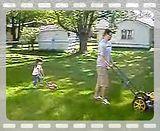Facebook Badge
Thursday, May 21, 2009
Thursday, May 14, 2009
Saturday, May 2, 2009
TROUBLE STARTING YOUR MOWER?
Wednesday, April 29, 2009
Sunday, April 19, 2009
Tuesday, April 14, 2009
Friday, April 3, 2009
ELEVEN LAWNMOWER CARE TIPS
Keep your Lawn Mower in Top Shape for Easier Lawn Care and a Healthier Lawn Remember when your lawnmower was brand new and started on the first pull? Regular maintenance will keep your lawnmower in top shape and running better longer. Tip One: Fresh Gas -- Fresh gas (87 or higher octane rated) is critical to an engine's performance. To fill the mower's tank, use a clean funnel to draw gasoline from either a one- or two- gallon gas can. Plastic gas cans are a good choice because they won't rust. If you own a five-gallon gas tank, dispose of it properly; the problem with a five- gallon can is that it provides the user with more than a 30-day fuel supply. Gas that is older than 30 days may affect engine performance. Moisture buildup and octane loss can lead to gum deposits in the engine's fuel lines and carburetor, which can lead to poor engine performance. Tip Two: Engine Oil -- Drain engine oil and replace it with clean SAE 30 engine oil after every 50 hours of operation. Check the lubrication section of your mower's owner's manual for specific oil recommendations. Tip Three: Spark Plug -- Replace the spark plug after every 100 hours of operation. Spark plug type and gap can be found in the product specifications section of the owner's manual. Tip Four: Air Filter -- If the mower's air filter is dirty, the engine may not run properly and may be damaged. Service the air filter after every 25 hours of operation or every season, whichever comes first. Remove the air filter cartridge and gently tap it on a flat surface. If the filter is very dirty, replace it with a new one. Tip Five: Mower Deck -- Disconnect the spark wire from the spark plug and position it where it cannot come in contact with the spark plug. Clean the mower housing thoroughly with soap and water, removing all dirt, grease and grass. For heavy grass buildup under the mower's deck, use a scraper. Tip Six: Blade Care -- For best results, lawn mower blades must be kept sharp. Lawn mower blades can be sharpened with a file or on a grinder wheel. Never attempt to sharpen the blade while it is on the mower. Special care should be taken to keep the blade balanced. An unbalanced blade will leave an uneven cut on the lawn and can eventually cause damage to the lawn mower or the engine. To check a blade's balance, drive a nail into a beam or a wall leaving approximately one inch of the straight nail exposed. Place the center hold of the blade over the head of the nail. If the blade is balanced, it should remain in a horizontal position. If either end of the blade moves downward, sharpen the heavier end until the blade is balanced. Tip Seven: Mulching -- Mulching is a great option to economically and consistently fertilize the lawn. With mulching mowers, small particles of grass are returned to the soil to biodegrade and serve as fertilizer. In fact, mulching can contribute up to 25 percent of the lawn's fertilizing requirements. When mulching, cut only one-third of the grass's height. Tip Eight: Engine -- Clean dirt and debris from the engine air screen and the engine's cylinder fins. Tip Nine: Power Propelled Mowers -- Replace any worn or damaged belts. To keep the driver system working properly, check the gear case and area around the drive system. It should be kept clean and free of grass and dirt buildup. Clean under the drive cover twice each season. Tip Ten: Gasoline -- Do not put four-cycle gas in a two-cycle engine. Lawnmower gas should not be used in the weed-whacker as the fuel is too lean. The weed-whacker may run for a while on the straight gasoline, but will eventually stop and be difficult or impossible to restart. Add oil to the fuel to put things right again. Tip Eleven: Gasoline -- Do not put two-cycle gas in a four-cycle engine. Weed-whacker fuel should not be used in the lawn mower as the fuel is too rich. The lawn mower may run for a while on the gas/oil mix, but will eventually stop and be difficult or impossible to restart because the oil has fouled the spark plug. Dump the gas/oil mixture out of the fuel tank, change the spark plug and put fresh, straight gasoline back into the tank. |
Picking the correct type of Grass for your climate
Many factors go into the selection of a type of grass for a particular lawn.
One of the overriding factors is your local climate. The so-called “warm-season” grasses are ideal for the southernmost states in the U.S., whereas “cool-season” grasses predominate in the North and in Canada. In between, for the Eastern U.S., lies the so-called “transition zone,” comprised of zones 6-7. This is a problematic area for growing grass: too hot for some grasses, too cold for others.
Common cool-season grasses include:
- Bentgrasses
- Bluegrasses
- Fescues
- Ryegrasses
Among the common warm-season grasses are:
- Bermudagrass
- Buffalograss
- Zoysiagrass
- Centipedegrass
- Bahiagrass
- St. Augustinegrass
Note, too, that lawns are not always composed of just one type of grass, but rather of a mixture, to take advantage of the strengths of each type.



